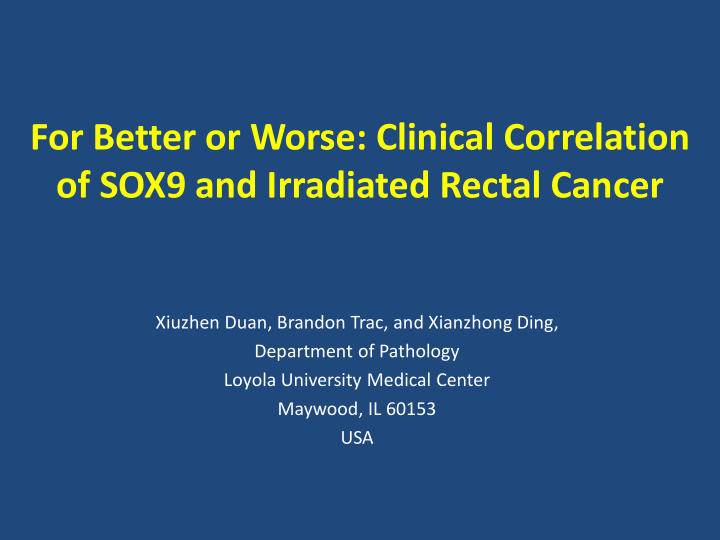



For Better or Worse: Clinical Correlation of SOX9 and Irradiated Rectal Cancer Xiuzhen Duan, Brandon Trac, and Xianzhong Ding, Department of Pathology Loyola University Medical Center Maywood, IL 60153 USA
SOX9 and Cancer Stem-like Cells • it is well accepted that cancer stem-like cells are the main driving force behind tumor formation, metastasis, and chemoresistance • Cancer stem like cells exhibit diverse cell properties including self renewal, differentiation capacity, and resistance to apoptosis and chemotherapy
SOX9 • Sex-determining region Y (SRY)-box 9 protein (SOX9) is a member of the SOX family of transcription factors • SOX9 participates in a variety of functions, such as tumor cell differentiation, stem-like cell lineage formation and epithelial mesenchymal transition • Role of SOX9 in colon cancer: controversial • Effect of chemoradiation on SOX9 expression unclear
Aims and Methods • The objectives of this study is examining SOX9 expression in pre- and post-irradiated rectal cancer • 25 patients with locally advanced rectal cancer – Moderately differentiated adenocarcinoma – Received neoadjuvant chemoradiation therapy followed by surgery
Aims and Methods • SOX9 expression – Evaluated by IHC – 4-tier grading system • 0: no expression • 1: low expression • 2: moderate expression • 3: high expression – Percentage of SOX9 positive cells
Pre-CRT post-CRT Pre-CRT post-CRT Non-tumor mucosa Adenocarcinoma
Pre-CRT post-CRT Pre-CRT post-CRT Non-tumor mucosa Adenocarcinoma
SOX9 expression and tumor response to neoadjuvant therapy • 2 cases with complete response to neoadjuvant therapy – High expression of SOX9 • No correlation of tumor volume reduction and SOX9 expression prior to chemotherapy • No association with lymph node metastasis and late distant metastasis
Conclusions • Role of SOX9 in colon cancer is still controversial • Might be a potential marker to predict tumor response to chemoradiation and oncological outcomes • Large cohort studies are needed to be conclusive
Recommend
More recommend